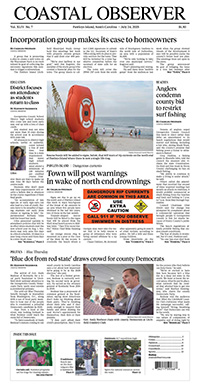Georgetown
Cleanup costs drive redevelopment plans for paper mill site

The cost of cleaning up contamination from 90 years of paper making is driving the deal to redevelop the International Paper Co. mill in Georgetown as an industrial site, according to a lawyer working on the proposal.
The plan to expand the mill’s power plant to generate electricity from burning biomass has drawn opposition from residents in the city’s West End who are concerned about the impacts on their health and the environment.
“To try to stop 1,000 jobs and a $4 billion investment is short-sighted, silly and dangerous, in fact,” said Stephen Goldfinch, an attorney who is handling the environmental side of the project and a state senator.
West End residents met earlier this month to discuss the project, a meeting that emphasized the need for more information. They have another meeting scheduled Friday with representatives of environmental groups, said Everett Carolina, a former Georgetown County Council member who is organizing the session.
It’s scheduled for 7 p.m. at the Soul Saving Station on Hawkins Street.
Goldfinch said he wasn’t invited to the meeting.
Neither was state Rep. Lee Hewitt, who has helped a buyer for the Liberty Steel mill make contact with local officials. He said the unnamed steel mill buyer also wants to buy the paper mill site, where operations ended in December. The steel mill also closed last year, and Liberty Steel plans a $1.2 million demolition of the facility.
“He’s ready to buy under certain circumstances,” Hewitt said of the steel mill buyer, adding that a “voluntary cleanup contract” with the state was the only condition he knew of.
The process known as a VCC protects the buyer of contaminated property from liability for the cleanup. The contract is between the buyer and the state Department of Environmental Services and specifies the level of cleanup needed.
But the contract also limits the liability of the seller, Goldfinch said.
That’s important because there is at least $100 million in cleanup cost for the paper mill site, he said, including two landfills and a wastewater treatment facility.
“The VCC program in South Carolina has never held the seller responsible,” Goldfinch said. “If you’re IP, what are you going to do?”
He said he has seen redevelopment plans for contaminated sites, known as brownfields, fall through because the buyer and seller couldn’t agree on apportioning the cleanup cost.
For the IP site, “there’s too much environmental liability,” Goldfinch said. “Nobody’s going to crack that nut for residential” development.
The level of cleanup is dictated by its proposed use, said Amy Armstrong, executive director of the S.C. Environmental Law Project.
The nonprofit, public-interest group has been involved in a VCC for a site in Greenville. Its attorneys have been invited to the West End meetings.
“SCELP’s role would be, first, we are very supportive of the community that lives in and around the IP facility,” Armstrong said.
Residents have traced long-term health issues in the community that they attribute to the mill.
“That’s a big reason for our involvement,” Armstrong said. “Second [is] ensuring the level of cleanup is compatible with the proposed uses.”
The biomass power plant and four related industries proposed for the IP site would make the cleanup affordable, Goldfinch said.
The work would involve adding a boiler fueled by burning biomass to the three boilers already on the site, he said. The buyers, who are also unnamed, would also like to add a boiler that would run on natural gas.
They also propose a sawmill, a data center and two facilities that will produce carbon black and hydrogen from wood for use in steel making. “The data center’s just receiving power from the biomass,” Goldfinch said.
Hewitt acknowledged that there is an increasing demand for electricity in South Carolina, but when he talked with officials at Santee Cooper, “they didn’t see biomass as part of their energy future.”
He questioned why a biomass plant couldn’t be built from the ground up in less time than it would take to cleanup the IP site and expand its power plant.
“This is what no one can answer: Why can’t you have both?” Hewitt asked. “If you need power now, why doesn’t it make sense to go somewhere else and start building it now?”
“There’s very little that’s going to have to be torn down,” Goldfinch said. That’s why the IP site makes sense.
He and Hewitt both said they haven’t spoken directly about the two mill sites.
The biomass plant would have less impact on the environment and the neighbors than the paper mill, Goldfinch said. But it would also use about twice the volume of wood.
“The wood industry in South Carolina is suffering tremendously,” he said. “It’s a major environmental concern not to have a place you can take pulpwood.”
The wood that is burned will come from thinning stands of pine planted for harvest, he noted. If the forests aren’t thinned, the trees won’t grow large enough to be used as timber.
Hewitt countered that he was told by people in the forestry industry that the biomass plant wouldn’t make up for the loss of the paper mill.
“You don’t see the forestry people out there jumping up and down saying this is going to save us,” he said.
Hewitt, who owns a real estate company, said he is not getting a commission for working with the steel mill buyer. And although he has also made an offer in the paper mill, Hewitt said “I’ll work with whoever buys it.”
The steel mill is within the city of Georgetown. The paper mill is just outside the city limits. Between them is the former state port, property that is now owned by Georgetown County due to an agreement Hewitt worked out in 2023.
Redevelopment of all three sites needs to be coordinated, he said.
“It’s going to be a long-term plan. There’s going to be a lot of cleanup at both sites,” Hewitt said, adding that the prospective buyer of the steel mill specializes in redeveloping brownfield sites.
The redevelopment will need local approvals as well as state and federal approvals and Hewitt told members of the county Republican club this week they needed to talk with their elected officials.
“At the end of the day, that’s where the decision is going to be made,” he said.
For the biomass project, a critical element will be the county’s willingness to approve a fee-in-lieu of taxes agreement. Those are regularly used to attract job-creating industries by reducing the taxable value of industrial property and guaranteeing a tax rate for a period of time.
“The county can force a really terrible deal,” Goldfinch said. If that happens, we’re going to end up with the same situation as the steel mill, an empty space.”
The biomass plant will employ 400 to 500 workers, he said, with an equal number working in the other facilities on the site. He added that those workers would come from those who were laid off when the paper mill closed.
“I’ve heard from dozens of people in support that lost their job at IP,” Goldfinch said.
While he said that there has been “manufactured opposition” to the biomass plant, he didn’t discount concerns from the West End residents.
“There are ways to try to make people happy with smokestacks and screening,” he said. “Those are very reasonable conversations to have.”




